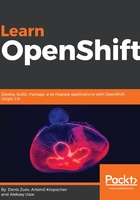
Preface
OpenShift is an application management platform that leverages Docker as an isolated runtime for running applications and Kubernetes for container orchestration. First introduced on May 4, 2011, it drew heavily from Borg— a container orchestration solution developed by Google engineers for managing hundreds of thousands of containers. In September 2014, it was redesigned, with Docker and Kubernetes becoming its main building blocks, and, since then, it has seen a large number of improvements and a growing community of users and developers. At the time of writing, the most recent version of OpenShift is 3.9, which became generally available on March 28, 2018, with 3.10 under development. Release 3.9 was the next one after 3.7, so technically, it incorporates changes intended for 3.8 as well, and represents a significant step in its life cycle.
Relying on Docker, OpenShift brings the true power of containerization to businesses, allowing them to respond quickly to ever-increasing demand from customers, and to maintain a good reputation by supporting high-availability and multi-data center deployments out of the box. From a business perspective, OpenShift reduces the costs associated with your investment by 531% over five years, with average annual benefits of $1.29 million and a packback period of 8 months of payback period—more details can be found at https://cdn2.hubspot.net/hubfs/4305976/s3-files/idc-business-value-of-openshift-snapshot.pdf.
Developers will find OpenShift's self-service portal easy to use, providing quick access to all features and deployment strategies, supporting unmodified source code, as well as Docker images and Dockerfiles, allowing developers to concentrate on development instead of managing their environment. OpenShift can automate every aspect of your release management by relying on Jenkins pipelines and integration with SCM.
For operations, OpenShift provides automatic failover and recovery, as well as high-availability and scalability, meaning that operations teams can spend their time on more high-level tasks. It can also be integrated with various SDN technologies developed by vendors other that Red Hat. And the fact that it relies on well-known technologies makes the learning curve shallow.
From a security standpoint, OpenShift can be integrated with corporate identity management solutions for user management and role assignment. It can expose applications to corporate security infrastructure for granular access control and auditing, protect sensitive data used by your applications, and manage access between different applications.
Examples in this book are demonstrated on OpenShift Origin 3.9, but all of them are applicable to Red Hat OpenShift Container PlatformTM as well due to their technical equivalence. The book is built in modular fashion, so if you feel that you are already familiar with certain topics, feel free to move on to another chapter.